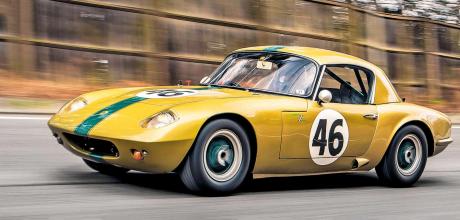1964 Lotus Elan 26R
One half of Ian Walker’s famous Goldbug duo, this Lotus Elan 26R helped forge the model’s racing legacy, being driven to victory by the likes of Jim Clark. Today it’s our turn behind the wheel. Words Ivan Ostroff. Photography Neil Fraser.
GOLD RUSH
Time for a track test of Jim Clark’s Lotus Elan 26R Gold Bug
On track in Jim Clark’s Silverstone-conquering IWR Lotus Elan 26R
The faired-in lights, cooling ducts set low into the flanks, magnesium alloy knock-off wheels and gold-and-green colour scheme hint at significance. Chassis number 26-R-33 confirms it – this is one of the two Elan 26R ‘Goldbugs’ deployed by Ian Walker Team Lotus for the use of Jim Clark, Peter Arundell, Sir John Whitmore and Tony Hegbourne for the 1964 racing season. Today I’m at Longcross test track to find out just how much more extreme this iconic 26R Goldbug is than the friendly little sports car on which it’s based.
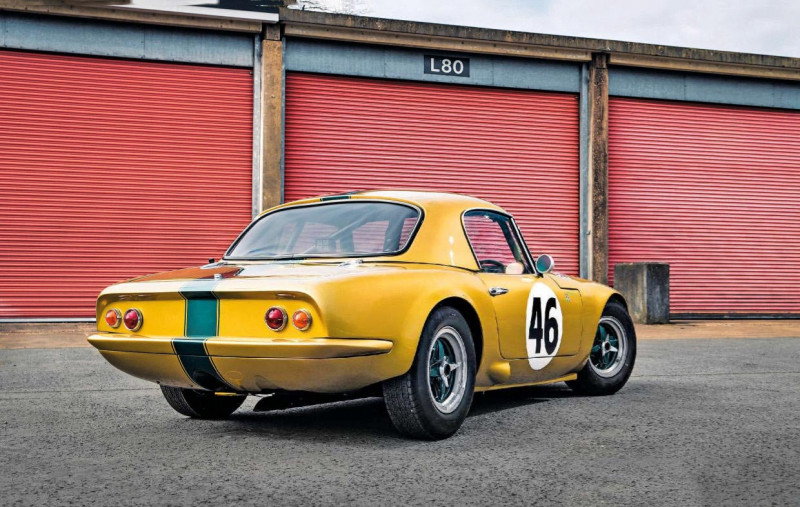
Today the car wears race number 46, a throwback to May 1964 when Whitmore won from pole in the GT1.6 Prix de Paris at Montlhéry. Before that it scored a series of class wins in the hands of Arundell, Clark and Whitmore, confirming the dainty Elan’s potential as a racer that could strike fear into the heart of many an E-type, GTO or Cobra pilot. Together they inspired numerous green-and-gold tributes – ironic, seeing as it was never supposed to be this way. And Lotus founder Colin Chapman never envisioned the Elan as a racer; Ian Walker did, but originally intended for his to wear metallic yellow. Gold paint turned up, he went with it anyway, and the rest is Lotus history.
I climb over the rollcage and drop into the low hotseat. For a moment I pause in eerie silence, in awe of the greats who have sat here before me. It’s snug. In the bulk of my driving suit and helmet, it’s difficult to move around and locate the Willans seat harnesses but an engineer from Hasu Racing, whose collection this Goldbug has been a part of for the past decade, is hovering close by and gets me sorted.
The gauges provide the driver with a gobbet of information – water/oil temperature, oil pressure and a 12,000rpm tachometer redlined at 7000rpm; a speedo was clearly deemed superfluous. I pump the accelerator twice to prime the two big Weber 45DCOEs that branch off the BRM-built Lotus Twin Cam ahead of me, then twist the key. The engine fires instantly and growls into exuberant life through the large rear-exit exhaust. With my foot just kissing the throttle I keep it idling just below 2000 while everything warms through.
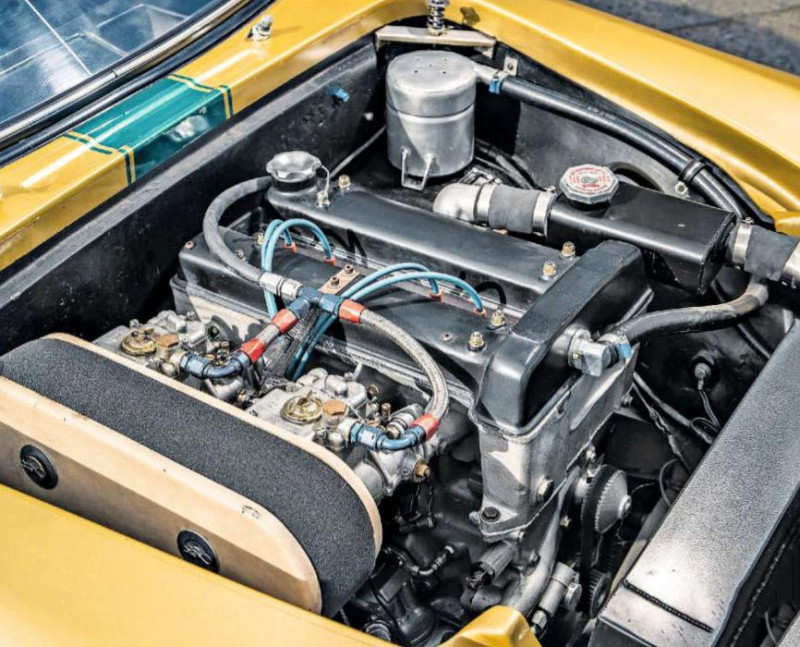
The lever slips forward easily into first gear with a satisfyingly notched precision. I increase the revs and gingerly bring up the clutch. On the move, the rackand- pinion steering lightens but everything feels taut and together through ultra-stiff rose-jointed suspension, a marked contrast to the pliant, forgiving ride of the road car. As I trickle out onto the track, I slip the lever back into second and ease into the throttle.
The 26R responds instantly, but I don’t tax it, just slip it up into third, and accelerate some more before pulling back into top. I haul on the wheel left then right to get a measure of the car’s attitude; it feels light and responsive. As the Dunlop Historic tyres get warmer, the grip begins to impress. Approaching a long lefthander, I brake hard. The 26R has larger front discs and smaller rears than the road car for a better braking balance, along with two master cylinders and a bias adjustment. The most dramatic thing about the process is just how pugnaciously this diddy machine can shed speed. With the apex met almost too easily, it’s clear I’ll have to recalibrate myself to get anywhere near this car’s limits.
A glance tells me the temperature is now at a healthy 80°C, so on corner exit I pull the aluminium gear knob back, across and back again into second, then bury the throttle. The Twin Cam instantly reacts to my RSVP and launches the car towards tomorrow, pushing my back into the bucket seat. As the tacho’ needle spools clockwise, the exhaust’s deeply thrumming bark grows into a rasping wail that cuts through the earplugs under my helmet.
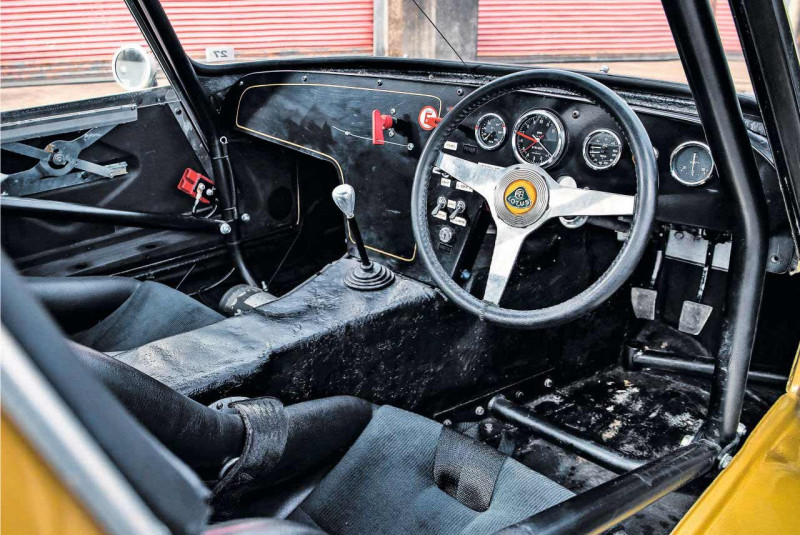
Standard 105bhp Elan engines were originally modified for the 26Rs by BRM. They were bored to 1594cc and according to a period Lotus Components Ltd printout, delivered at least 145bhp. To achieve this they were stripped and reassembled to racing specification, a process that included balancing the reciprocating parts, and polishing and modifying the cylinder head. Special racing pistons with two Dykes-type compression rings and one oil control ring were fitted, as well as modified camshafts, special steel con-rods, racing valve springs and Vandervell steel-backed lead indium bearings. They were often further modified however – this engine currently produces 175bhp at 7500rpm as a result of the original Ian Walker Racing modifications.
The power band is between 5000 and 8000rpm and the pull of the engine is strong and linear up to 7000, which I’ve agreed not to exceed. Maximum torque of 130lb ft is made at 5500rpm, 500rpm higher than the road car. The needle flicks around the tacho’ unbelievably quickly; with no speedometer to reference, I can only guess my speed – which feels mighty fast – until I reach 7000 in top, which equates to almost 120mph with the current axle ratio.
I’m settling in now and as I approach the left-hander at the end of the straight, I jump onto the brakes. The Girling AP1 calipers chow down on the discs and the Lotus dumps speed instantly. I roll the side of my foot over the throttle and the engine growls as I slip through neutral into third, double de-clutching on the way. As I turn in, I can feel everything through the steering just like I would in the road car – very little was changed in this regard to make the 26R battle-ready – and where I would be expecting any other car to enter a slide, the 26R just grips resolutely. Trying to provoke a high-speed drift would be unnecessary, bordering on negligent. Even cornering at 6000rpm in top, the Lotus steadfastly refuses to relinquish its grasp of the road’s surface ground, and there’s no untoward sideways movement.
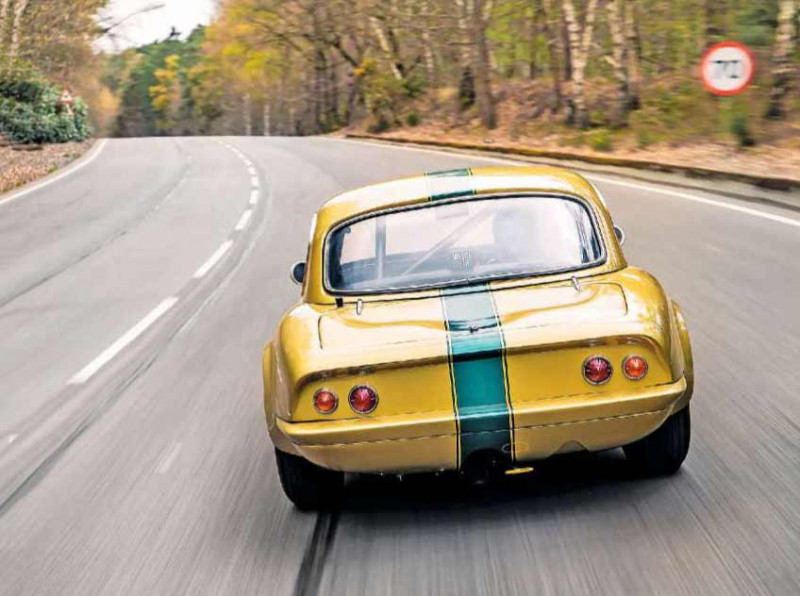
As I turn into a tight right, the 26R remains stable with barely any perceptible roll. I squirt the throttle on exit and this time the tail does start to slide but there’s no spinning up of the inside rear wheel thanks to the limited-slip differential. I flick the leather-rimmed wheel to correct the front end, and the 26R remains neutral and predictable. This car feels like it can outbrake and outcorner anything; it’s quicker through any corner than any other car I’ve driven. As good a road car as the standard Elan is, its rubber bushes will allow considerable movement, while the rose joints of a 26R will ensure there are negligible losses through the suspension. It has far stiffer springs and dampers plus a rear anti-roll bar that the standard road car doesn’t. Its front anti-roll bar is at least twice the diameter of the standard road car item.
Ricketts Racing chief race engineer Mike Loughlin explains, ‘Chapman had a thing about soft springs, so the standard Elan is softly sprung by today’s standards. The 26R sits lower and the springs are markedly different, being at least three times stiffer than in the road car, and there are adjustable competition dampers all round. The rose joints allow you to adjust everything; the front end has competition wishbones that are adjustable for camber. At the rear, camber and toe adjustment is provided by a special wishbone with threaded spherical bearings at the inboard end, and there are solid driveshafts. There are also close-ratio gears and the rear drivetrain is different, with an aluminium bell housing, tail shaft and differential nose piece, plus a magnesium differential casing.
‘A standard road Elan weighs 700kg and the homologated minimum weight for a 26R is 580kg. Then the unsprung mass is significantly lower thanks to the magnesium wheels and carriers for the bronze front hubs. You also have more power, the limited-slip differential – it’s simply a completely different proposition. Also the Twin Cam was used in F2, so it’s among an elite few GT cars whose engine was also used in a single-seater Formula, like the Porsche RSK, Dino 206, and Alpine-Renault A110 Gordini.’
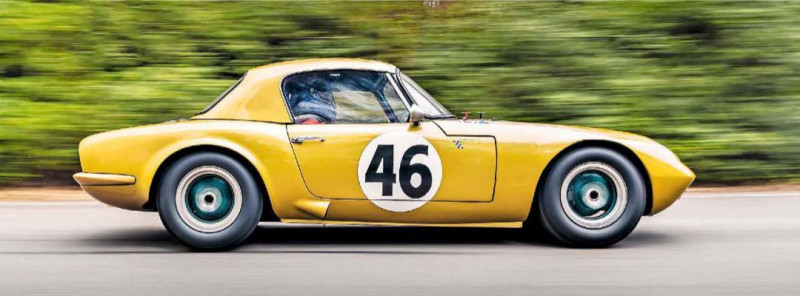
Loughlin adds, ‘Although the two cars resemble each other, the only components that the 26R shares with a standard Elan are the steering column, rack and possibly the front uprights; everything else is different and the chassis is much stiffer. It also starts with good weight distribution, independent suspension all round, disc brakes all round – semi-inboard at the rear – all things that you include when designing a race car.’
This makes it all the more remarkable that Chapman never intended to campaign the Elan. But in 1963, Lotus had so many motor sport projects running, it was finding it difficult to cope. There was the F1 Lotus 25 that had given Jim Clark his first World Championship, the Indycar that Ford had asked Chapman to develop, the F2 and F3 cars, Group 7, and of course the Cortinas.
The Elan had been launched in 1962 with the intention of establishing Lotus as a genuine road car manufacturer, and provide the main source of the firm’s income. The value and performance of the Elan is well documented – trouble was, the latter element was so compelling that customers soon wanted to race them. Whereas the Elite before it was conceived as a racer, the Elan was designed solely for the road. When Elan owners began using them on the track, the fragility and dubious beyond-limit handling was exposed.
In 1963, Chequered Flag proprietor Graham Warner began campaigning the Elan, he too encountering its competitive shortcomings. Beyond its limits, predictable understeer suddenly became frightening oversteer. In Warner’s first race at Silverstone, he also found that the chassis was flexing and the rear wishbones had twisted by more than 20 degrees. The Triumph-sourced Rotoflex couplings would also fail, a weakness that would be addressed with sliding spline joints. Nevertheless, by the end of the season Warner had managed to develop the Elan into a decent racer. Chapman was initially against the idea; when he saw Warner was doing well he realised that its competitive use was inevitable. As a result of the data that Warner subsequently passed to Lotus Components, the factory produced the purpose-built 26R racer.
In 1964 Chapman had Warner campaigned a pair of 26Rs but to hedge his bets, he struck a second deal with Ian Walker’s eponymous racing team. Jim Clark and Peter Arundell would drive two 26Rs for what became known as Ian Walker Team Lotus; Sir John Whitmore and Tony Hegbourne would be the reserves. IWTL debuted at the 1964 Goodwood Easter Monday meeting. Arundell, driving 26-R-33 – at that point painted yellow and green – beat Mike Spence’s Chequered Flag Team Lotus 26R to take a class win in the Sussex Trophy after a race-long nose-to-tail battle. Denis Jenkinson wrote, ‘Arundell and Spence in new competition Lotus Elans were giving Sargent a bad time in his E-type Jaguar and they eventually got by, causing consternation in Coventry.’ It was the start of the 26R’s career where it so often punched above its weight.
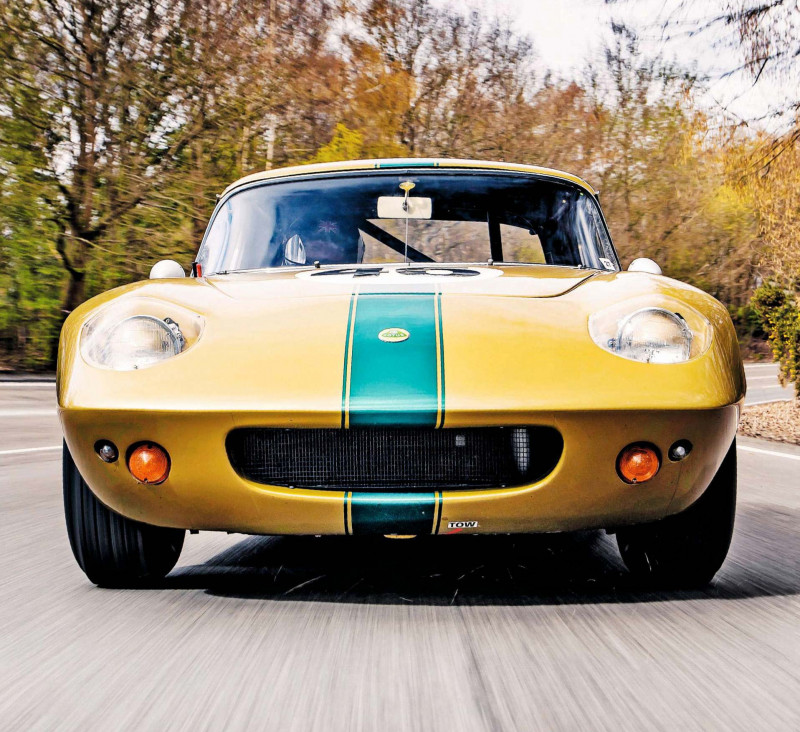
In the Oulton Park National GT race on 11 April, Jim Clark beat the Chequered Flag car to the win in 26-R-33. It was after this that Walker decided to freshen up his 26Rs and placed the fateful order for new paint. The ‘Goldbugs’ were about to be born.
The two IWR cars were unveiled at the Silverstone Daily Express race meeting on the 2nd May. With Clark this time driving 26-R-33 and Arundell in the sister car, they came first and third in class. The Lotus adverts proudly declared ‘race proven for road reliability’ with an image of the newly christened Goldbugs flanking Jackie Stewart in the Chequered Flag Elan.
On 17th May, Peter Arundell was second in class driving 26-R-33 at Mallory Park. Then on 24 May, John Whitmore drove it to outright victory from pole at Montlhéry. It had quickly become clear that they were the cars to beat in the GT1.6 category.
On 11 July Whitmore placed second in class behind Peter Procter’s Chequered Flag 26R in the Ilford Films Trophy at Brands Hatch.
Although there were just two Goldbug Elan 26R coupés campaigned by IWR, Ian Walker also planned to enter the 1964 Le Mans 24 hour race in an Elan with a more slippery body fashioned by Williams & Pritchard in aluminium from Walker’s own drawings. It won its class and finished fourth overall on its maiden outing at Montlhéry in Jackie Stewart’s hands, but Mike Spence crashed it badly while practising for the next race at the Nürburgring. Although this car was also painted gold with green stripes it’s not generally referred to as a Goldbug. Similarly, Ian himself rallied a 26R in 1966; this car was painted yellow with green stripes but it never assumed the same sobriquet. The original Series 1 sisters remain the only IWR Goldbugs.
In 1965, 26-R-33 was bought by Peter Creasey and painted blue, and raced throughout that season. It was campaigned in historics in the Seventies, moving through several owners and being repainted back to gold before being bought by Californian Don Orosco in 1984. During the Nineties it went to Alex Bollinger and then in 2000 to John Delane before Hasu Racing acquired it in 2011.
Given Mike Loughlin’s intimate relationship with chassis 33, he seems ideally placed to sum it up. ‘It’s the closest thing to a correct GT racing car of period F covering pre-1965, which includes E-types and Cobras – pretty crude devices back then by comparison. The basic layout is so brilliant that if a racing Elan were given more power, nothing would beat it. And I mean nothing.’
Thanks to: Hasu Racing Ltd (info@ hasuracing.com) and Mike Loughlin of Ricketts Racing (07714 246 270)
TECHNICAL DATA FILE SPECIFICATIONS 1964 Lotus Elan 26R
- Engine 1594cc straight four-cylinder, dohc, two Weber 45DCOE carburettors
- Max Power 175bhp @ 7500rpm
- Max Torque 130lb ft @ 5500rpm
- Transmission Four-speed manual, rear-wheel drive
- Steering Rack and pinion
- Suspension
- Front: independent, wishbones, coil springs, adjustable dampers, anti-roll bar.
- Rear: independent, Chapman struts, coil springs, adjustable dampers, anti-roll bar
- Brakes Discs front/rear
- Weight 580kg
- Performance 0-60mph: 5sec;
- Top speed: 135mph
- Cost new £2095 (ex-works, export only)
- Approximate value £300,000
Around 95 Elan 26Rs are believed to have been built, circa 52 of which were Series 1s. Chassis 33 is among the most famous and significant of them all
‘It’s among an elite few GT cars whose engine was also used in a single-seater Formula’
IAN WALKER – THE GOLDBUG MAN
Born in London, the son of a Scottish carpenter, Ian Walker served in the RAF during WWII, then evolved his father’s business into a firm that built promotional model aircraft. Its success paid for Walker’s club-racing hobby. He began by rallying his Sunbeam-Talbot 90 in 1954, before meeting Colin Chapman and Graham Hill. He switched to circuit racing after buying a Lotus Eleven.
Walker set up Ian Walker Racing (IWR) in 1962, officially as a privateer competition outfit, albeit with privileged access to Lotus cars. Chapman had supplied Walker with a prototype Elite for club racing in 1958, his success with it helping to promote the car, and upon Walker’s retirement from racing, he decided to field his own team running other drivers. IWR fielded Formula Junior and sports-racing entries, and helped develop racing cars for Chapman, including the 26R. As well as the aluminium-bodied Le Mans fastback, Walker also persuaded Chapman to create a Can-Am car, which became the ill-fated Lotus 30. Walker later focused on car and parts sales, and supporting son Sean’s racing career.
‘Goldbugs struck fear into the heart of many an E-type, GTO or Cobra pilot
IWR’s work developing the 26R earned it a stellar reputation Tester Ivan gets ready to find the limits of this steroidal Elan; they’ll prove quite a reach away [Lotus Elan 26R ] Various air ducts were used to cool the rear differential; today modern oils solve the problem. Rollcaged cockpits were stripped of anything not deemed vital, including a speedometer. Pedal box is bespoke. The humbling view often seen by more potent machinery.78 Tony Hegbourne in chassis 33 at Brands Hatch, Whitmore touching head in background A Goldbug in the IWR pits at Brands Hatch; note experimental rear wing duct to cool differential Clark at Silverstone in chassis 33 Whitmore in the Martini Trophy at Silverstone, 1964 Whitmore chases a Morgan Plus 4 SLR at Brands Martini Trophy, Silverstone The Goldbug’s reveal at Silverstone, May 1964. Clark (in chassis 33, #16) wins class with Arundell (#17) second.
Also at Silverstone, 2 May – Arundell passes Chris McLaren’s Marcos GT Ford in the sister car.
Cornering performance is so good, it’s difficult for even a seasoned road tester to believe.
Driver’s perch is inches away from the road, and it feels it Love that funky green-on- gold colour scheme?
It came about after a mix up with the paint No chances taken, considering both monetary and historic value Magnesium wheels reduce unsprung weight The car still sees action at the sharp end of competitive grids. Weber-carbed twin-cam has 8000rpm+ Potential. Around 95 Elan 26Rs are believed to have been built, circa 52 of which were Series 1s. Chassis 33 is among the most famous and significant of them all.


